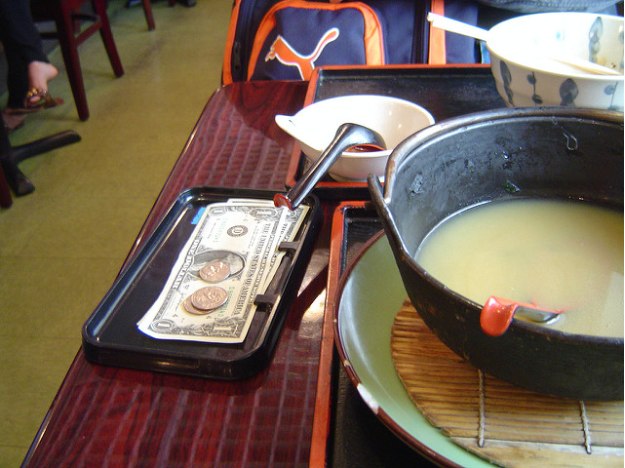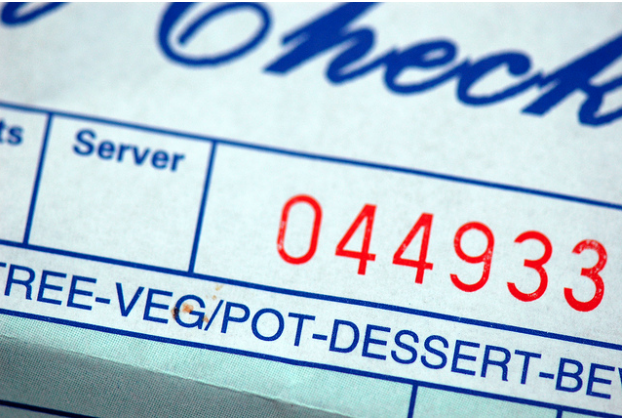
(Source: Flickr)
For many of us, tipping is simply part of the experience of dining out. It’s customary and expected to add 15 to 20% of the billed amount for service; more or less depending on the diner’s satisfaction. But have you ever wondered why we tip, or where the money actually goes? Here, we’ll explore the custom of tipping, as well as how some restaurateurs are challenging the traditional tipping format and what this means for the future of dining out.
What is tipping and why do we do it? Tipping may seem like a purely American tradition, but the custom is actually said to have originated in Europe. In fact, some say that the word “tip” evolved in English taverns as an acronym for “to insure promptitude”.
While today, tipping customs vary in Europe, it’s commonplace in the United States. In the USA, is a generally accepted custom when eating out; it is also customary for some services, such as taxi rides, haircuts, and beauty treatments. A tip is to reward the server (or person performing the service, in non-culinary settings) for their service, but it is also to ensure that they earn a living wage, since many of the jobs in question are paid very low hourly rates, which would not be enough to live off of without the income from tips.

(Source: Flickr)
How do we tip? The amount of a tip is ultimately decided by the customer. So how does the customer decide how much to pay?
While the particular tip left by one person or another can vary depending on their personality, likes, and dislikes, in general, restaurant tips typically fall between 15 to 20% of the amount of the final bill. For instance, to leave a lower 10% tip would mean that the diner is dissatisfied; 15% means the experience was acceptable but not much more, and 20% or higher is typically rewarded for a stellar experience. To not leave any tip is considered insulting, and is usually only done when the dining experience was not only not good but actively bad.
Where do your tips go? Many people assume that their tip goes directly to the server, but this is not always the case. Many restaurants “pool” their tips, which means that the server tips are partially paid out to the back of the house restaurant staff. This is a good thing for the back of the house staff, whose hard work is a huge part of a server’s success. However, keep in mind that if you leave a poor tip, it’s not only the server who is affected.

(Source: Flickr)
Tipping methods. Here is a brief overview of some common different tipping policies, which also touches on the advantages and disadvantages of each.
Counter tip (tip jar): At informal types of restaurants such as coffee shops or casual cafes, where you are ordering and paying at the counter rather than having your order taken and items delivered by server, it’s common to see a tip jar on the counter.
There are many differing opinions on the counter tip jar. Some treat it the same as a restaurant tip, leaving a percentage of their total bill. Others will leave a dollar or small amount from what they were given as change. Yet others don’t leave a tip at all, figuring that counter staff is at least receiving minimum wage. It can be a polarizing subject, and not much has changed since this New York Times article over 10 years ago.
Tip on the check: This is the most widely spread type of tipping. A check is delivered with the total amount; it is the customer’s responsibility to pencil in a tip amount (for credit card sales) or leave a cash tip. As previously noted, the tip amount will typically fall between 15 to 20%.
For a high volume restaurant, this can mean that servers take home generous pay. However, there can be a lot of factors that affect the amount left, from the customer’s personality type to how busy the restaurant is at a given hour, which make it a sometimes inconsistent practice.
Large party gratuity: In many a restaurant, if you’re dining with a large group, a gratuity will be included in the bill. As a common example, many restaurants will add an 18% gratuity for groups of six or more, although this can vary from establishment to establishment.
The large party gratuity helps offset the extra space and work that a large party requires, but it can be confusing for diners, especially if they are not told that they will be charged this amount. So if you’re dining with seven of your closest friends, be sure to look at the check before adding a tip: chances are, you may already be paying one.
No-tip policy: If a restaurant has a no-tip policy, the customer is not to offer a gratuity on their meal. Usually, a restaurant is paying their employees minimum wage if they do this. This means that the employees will earn a fair wage regardless of how busy the restaurant is, and cheap tippers won’t affect their pay. However, it does not necessarily reward exceptional service.

(Source: Flickr)
What is the future of tipping? While it is still not widely spread, the idea of no-tipping policies is beginning to get traction, especially since famed chef Danny Meyer made the polarizing announcement that he was going to ban tipping in all of his restaurants, instead opting to raise the prices of menu items so that he could pay his employees a fair, living wage and to keep things simple for customers.
The concept of no-tipping establishments is getting more press, but it still remains to be seen if this idea will take over the deeply rooted tradition of tipping in restaurants.
Conclusion: Tipping is a simple practice, but the many different formats of tipping as well as the psychology that goes into the tradition can make it quite complex. Ultimately, it is important to compensate staff and servers in a fair way, but it’s possible that the customary method of tipping on the total bill may be changing in the years to come.
What is your favored tipping policy?


